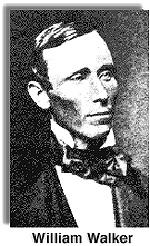 William Walker was another imbued with the desire of founding a colony in Mexico, near the American border. His aim, however, was to obtain the independence of Sonora and Baja California for the ultimate annexation to the United States, and for the extension of slave territory so as to maintain the balance of power for the South.
William Walker was another imbued with the desire of founding a colony in Mexico, near the American border. His aim, however, was to obtain the independence of Sonora and Baja California for the ultimate annexation to the United States, and for the extension of slave territory so as to maintain the balance of power for the South.
He was always a firm slavery advocate. This caused him to look with some apprehension upon the efforts of the French filibusters, for the slavery party regarded the American conquest of Mexico as a matter of manifest destiny, to which French interference would serve as a serious obstacle. Raousset’s, a French Filibuster, plan for a second expedition spurred Walker on to immediate action.
He thereupon opened a recruiting office in San Francisco. Recruits flocked to join his band, many of whom were from Kentucky and Tennessee, and were therefore adherents of slavery and the manifest destiny doctrine. Walker now cast aside all ideas of founding a buffer colony and stated his intention of forming a republic in Sonora and Lower California, with the idea that it would eventually apply for admission into the Union.
In July, 1853, he organized an expedition for the conquest of the state of Sonora, Mexico. On October 16th, Walker used the “Caroline” to carry his forty-eight followers to Guaymas. Three weeks later he reached the Gulf of California. Early in November landed at La Paz, Lower California, with 170 men and three field-guns. Here he was reinforced by two hundred men, and so he took possession of the country and proceeded to set up a government. Since his supplies were already so greatly depleted, he was forced to divide his force and send a band of men on towards Todos Santos Bay, on a foraging expedition. At Guilla, near Santo Tomas, a battle was fought, for the natives did not care to give up their cattle and provisions in return for scrip in Walker’s company.
Realizing that his position here was not secure, and that he was exposed to easy attack on the part of the Mexicans, he retired up the peninsula towards Ensenada, after a skirmish with the Mexicans at La Paz. He made Ensenada his headquarters, and from here he issued a new proclamation, abolishing the Republic of Lower California and establishing the Republic of Sonora, which was to consist of the two states of Lower California and Sonora. Walker, himself, was to be president.
The skirmish at La Paz was regarded as a great victory.. Hundreds of men flocked from the mines to join the expedition. The flag of the Republic of Sonora was raised in San Francisco. Walker now began to drill his band in preparation for a march on Sonora. But discontent had broken out in his party. The new-comers were disappointed that there was no plunder to be had. Food was insufficient and coarse. Men began to desert and some weeks later it was with a force of only one hundred men that Walker started for Sonora, and by the time they reached the Colorado River only thirty-five men remained in the party.
It would take more than this mere handful to hold the country, and so Walker decided to abandon the project. On May 8, 1854, the party crossed the frontier near Tia Juana, and surrendered themselves to the United States officers stationed there. Had Walker’s party reached Sonora, and gotten any kind of a foothold there, so many volunteers would probably have joined them that Sonora and Lower California would have become territories of the United States.
William Walker In Mexico and Nicauragua
Back to Time Portal Passages Spring 2005 Table of Contents
Back to Time Portal Passages List of Issues
Back to MagWeb Master Magazine List
© Copyright 2005 by Rudy Scott Nelson
This article appears in MagWeb.com (Magazine Web) on the Internet World Wide Web. Other articles from military history and related magazines are available at http://www.magweb.com